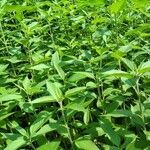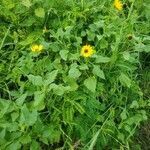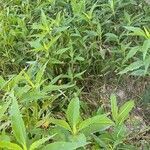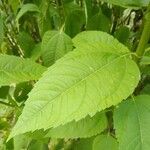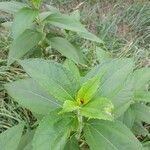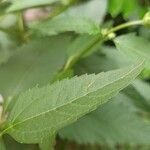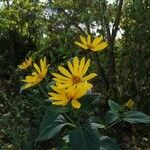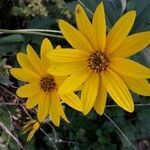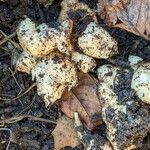Herbs, perennial, 50-200 cm, rhizomatous, producing tubers late in growing season. Stems erect, scabrid-hispid to hirsute, sometimes glaucous. Leaves mostly cauline, opposite or alternate proximally, usually alternate distally; petiole 2-8 cm, often ± winged; blade lanceolate to ovate, 10-23 × 7-15 cm, 3-veined from near base, abaxially puberulent or hirsutulous to tomentulose and gland-dotted or ± scabrid, base broadly to narrowly cuneate, margin entire or serrate. Capitula 3-15; peduncles 1-15 cm; involucres hemispheric, 10-25 × 8-12 mm; phyllaries often dark green, drying nearly black, 22-35, subequal, lanceolate, 8.5-15 × 2-4 mm, abaxially hispidulous or puberulent, gland-dotted, base appressed, margin ciliate, apex ± spreading, sometimes reflexed in fruit, acuminate; paleae 8-9 mm, 3-toothed, apices hairy. Ray florets 10-20; lamina 25-40 mm. Disk florets 60+; corollas 6-7 mm, lobes yellow; anthers dark brown or black, appendages dark or yellowish. Achenes 5-7 mm, glabrous or apically hairy; pappus of 2 aristate scales 1.9-3 mm plus 0-1 deltate scales 0.5-0.8 mm. Fl. Aug-Sep. 2n = 102.
Erect perennial herb, with short rhizomes and well developed tubers. Stems hispid, not or sparingly branched, up to c. 3 m tall, dying back to tubers in winter. Lower and mid cauline lvs hispidulous, petiolate, narrow-ovate to deltoid or rhomboid, acuminate, obtuse at base, irregularly serrate, (8)-20-25 cm long, often with short shoots and reduced lvs in axils; upper cauline lvs similar to lower but alternate and uppermost shortly petiolate, smaller and narrower. Capitula 5-8 cm diam., in loose corymbs of 2-6. Involucral bracts in 2-3 rows, sparsely hairy and ciliate, narrow-lanceolate, acute, 8-15 × 2-4 mm. Receptacle convex; scales membranous, the larger with darker ciliate apices. Ray florets 10-15; disc florets numerous, yellow or tinged brown. Achenes narrow-obovoid, hairy toward apex, 4-6 mm long; pappus of 2-5 laciniate scales.
Perennial with well developed, commonly tuber-bearing rhizomes; stems stout, 1–3 m, ± spreading-hairy; lvs numerous, those of the upper half or 2/3 of the stem alternate in well developed plants, scabrous above, short-hairy beneath, broadly lanceolate to broadly ovate, the better developed ones mostly 10–25 × 4–12 cm, serrate, abruptly contracted or somewhat tapering to the winged petiole, this 2–8 cm; heads often many in a corymbiform infl, the disk yellow, 1.5–2.5 cm wide; invol bracts rather dark, especially near the base, narrowly lanceolate, acuminate or subattenuate, loose especially above the middle, often hispidulous; rays 10–20, 2–4 cm; 2n=102. Moist soil and waste places; nearly throughout e. U.S. and adj. Can., and w. across the Great Plains. (H. subcanescens, small plants with chiefly opposite lvs)
Erect perennial herb with short rhizomes and tubers, (0.4–) 1.5–3 m high; stems green to reddish purple, hirsute. Leaves petiolate, ovate to lanceolate, 3–16 (–20) cm long, 3–9 cm wide, toothed; both surfaces scabrous; upper leaves mainly opposite. Capitula in groups of several to numerous, erect, c. 1.5 cm diam. (excluding rays) or 3.5–6 cm (including rays); peduncles hairy; involucral bracts linear to lanceolate, gradually acuminate, hirsute or ciliate on margins; paleae long-awned with shorter deltoid lateral lobes, weakly striate. Ray florets yellow; ligules (15–) 25–30 (–40) mm long. Disc florets numerous, yellow. Achenes obovoid to subcuneate, 4-angled, 4–6 mm long, dark grey, minutely hairy towards apex. Pappus of 2–5 early caducous scales.
An upright perennial plant up to 1-2 m high and a spread of 1 m. The stem is erect and unbranched. The leaves are dull green and sword shaped. The flowers are yellow and daisy like. It produces fleshy underground stem tubers of irregular shape. The skin of these tubers is very thin and often coloured yellow or red. The flesh is white. Tubers can be 10 cm long and 6 cm wide. There are several cultivated varieties.
